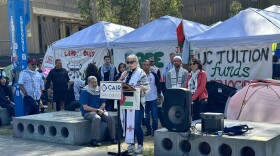San Diego County is stepping up its fight against Alzheimer’s disease with the help of a $1.3 million federal grant. The funding comes as new research shows the disease is escalating in the region.
San Diego County leaders and brain scientists gathered in La jolla on Friday at the Sanford Burnham Prebys Medical Discovery Institute to announce the funding and share daunting new statistics: 84,000 people in San Diego County have the disease or related dementia, and that number is expected to soar 36 percent by the year 2030.
"One out of every ten San Diegan over the age of 55 is afflicted with Alzheimer’s or the related dementia. That’s a huge burden," said Leslie Upledger Ray, senior epidemiologist with San Diego County Public Health Services.
"Nationally, Alzheimer’s is the 6th leading cause of death. In San Diego, it’s the third leading cause of death," she added, citing a rise in the county's aging population.
The progressive disease is expected to put an enormous strain on the health care system, families and the economy, said Upledger Ray, because patients require 24-hour care, costing upward of $65,000 annually.
"Right now there’s no cure for Alzheimer’s," said Dr. Jerold Chun, professor and senior vice president of the Sanford Burnham Prebys Medical Discovery Institute.
He said a more realistic short term goal is to make the disease more tolerable.
"To slow the progression would be great," Chun said. "A lot of the agents are designed to treat ... the signs and symptoms of the disease. So for example, to improve cognition."
It's the kind of research underway at the Conrad Prebys Center for Chemical Genomics, where scientists are seeking medical breakthroughs and drug discoveries, with a key focus on neurodegenerative diseases, including Alzheimer’s.
"For instance, using patient specific stem cells to produce disease relevant cell types like neurons from Alzheimer’s patients," said Anne Bang, director of cell biology.
The Center is part of a collaborative project receiving the National Institutes of Health grant aimed at bolstering research to find a cure. Participating with Sanford Burnham Prebys are The Salk Institute, The Scripps Research Institute, J. Craig Venter Institute and the University of California, San Diego.
Two studies released Friday indicate San Diego County will see increasingly devastating health and economic effects from dementia-related diseases in coming years.
The number of county residents age 55 and older with dementia is expected to increase from 84,000 today to 115,000 by 2030, according to The Alzheimer's Project, a regional initiative that includes political leadership, research institutions, public universities, health care systems and caregiver groups.
Alzheimer's is the most common type of dementia, which is an umbrella term signifying a decline in mental ability. Vascular dementia, the second most common form of dementia, typically affects stroke patients.
The number of family members and caregivers needed for dementia patients is expected to grow from 214,000 people to nearly 300,000. Meanwhile, the current cost of dementia care in the county, $38 billion, is expected to grow by $52 billion by 2030.
Annual costs associated with an individual with dementia are estimated to be more than $64,000; that figure includes medical costs as well as loss of income and productive activity.
In 2015, about one in seven San Diego County hospital patients age 55 or older showed signs of dementia.
The San Diego County Board of Supervisors launched The Alzheimer's Project in 2014 to mitigate the growing effects of dementia. The coalition is focused on improving the county's network of care services and raising awareness and funds for an Alzheimer's cure.






